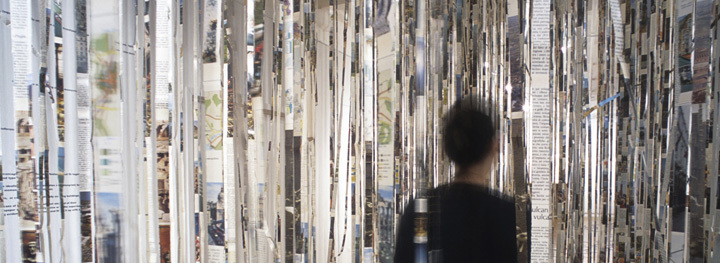Art & Art History
Demonstration Room: Ideal House

Gallery 400
400 South Peoria Street, Chicago, IL 60607
Francis Alÿs, Carla Arocha, Atelier van Lieshout, Anna Best in collaboration with Gemma Nesbitt, Stefan Bruggeman, Mariana Bunimov, Minerva Cuevas, Stan Douglas, José Gabriel Fernández, Carlos Garaicoa, Alexander Gerdel, Liam Gillick, Dan Graham, Jeanne van Heeswijk, José Antonio Hernández-Diez, Gabriel Kuri, Diana López, Mauricio Lupini, Rita McBride, Carlos Julio Molina, Ernesto Neto, Claudio Perna, Proyecto Incidental, Paul Ramírez-Jonas, Juan Carlos Rodríquez, Karin Schneider, Javier Téllez, Meyer Vaisman, and Sergio Vega
In a space designed to mimic an architect’s office, Demonstration Room: Ideal House presents proposals, architectural models, and other forms of artwork investigating the idea of house as domestic utopia. Curated by two South American curators, Jesús Fuenmayor and Julieta González, the exhibition includes work commissioned from some of today ’s most interesting artists.
By using the architect’s office as a model for display, Demonstration Room: Ideal House blurs the boundary between artworks and exhibition space, demonstrating how context is critical to our experience of art.
The exhibition layout, inspired by El Lissitzky’s 1920s Demonstration Room, supplants the romantic notion of a pure, epiphanic art experience with a historically situated and critically informed understanding of art. By using the architect’s office as a model for display, Demonstration Room: Ideal House blurs the boundary between artworks and exhibition space, demonstrating how context is critical to our experience of art.
The works in the exhibition are framed by four overlapping themes: 1) Urban nomadism as facilitated by mobile living units 2) the house as Gesamtkunstwerk: a holistic, total work of art 3) collective housing and experiments in communal living 4) shantytowns as they illuminate and critique utopian ideals. One artwork on the theme of collective housing is Anna Best’s Anti-Lonely House. Anti-Lonely House is a communal living model, which addresses the needs of senior citizens and immigrant workers through the design of the Panopticon. On the subject of the shanty, Sergio Vega’s Vertical Displacement Within the Same Class is a series of photographs that juxtaposes a contemporary Latin American shantytown with the Garden of Eden, which was alleged to have been located on the very same site as the shantytown.
Although the artists in Demonstration Room: Ideal House employ diverse strategies in addressing these subjects, they share a common critical understanding of the relation between art project and art object. In this exhibit, conceptual proposals, ephemeral interventions, scale models, and fully materialized works occupy positions of equal importance. One of the more conceptual/ephemeral works in this exhibition is by José Antonio Hernández-Diez, whose untitled piece consists of a series of ads in local Chicago newspapers, in which he either solicited or offered the “houses” proposed by some of the artists for the show. His ads projected into the public sphere show his own and others ’ desires for an “ideal house,” while at the same time frame the “ideals” of other artists within the limits of the real world. On the more experiential/physical end of the spectrum is Javier Tellez ’s LC/4 R-Machine, a person-size plywood crate containing a LeCorbusier chaise lounge and a video monitor. The viewer reclines on the lounge inside the crate and watches a video of a catatonic schizophrenic patient, while Bach ’s Goldberg Variations plays in the background. LC/4 R-Machine reflects on mental illness as a by-product of modernism and demonstrates how architecture affects our understanding of borderline states.
Demonstration Room: Ideal House is the premier exhibition in Gallery 400’s new architectural exhibition program. The exhibition originated in Caracas, Venezuela at Museo Alejandro Otero and traveled to Apex Art in New York and the New International Cultural Center in Antwerp, Belgium.
The exhibition will be accompanied by an artist lecture by Mauricio Lupini, as well as a discussion with curators Jesús Fuenmayor and Julieta González.